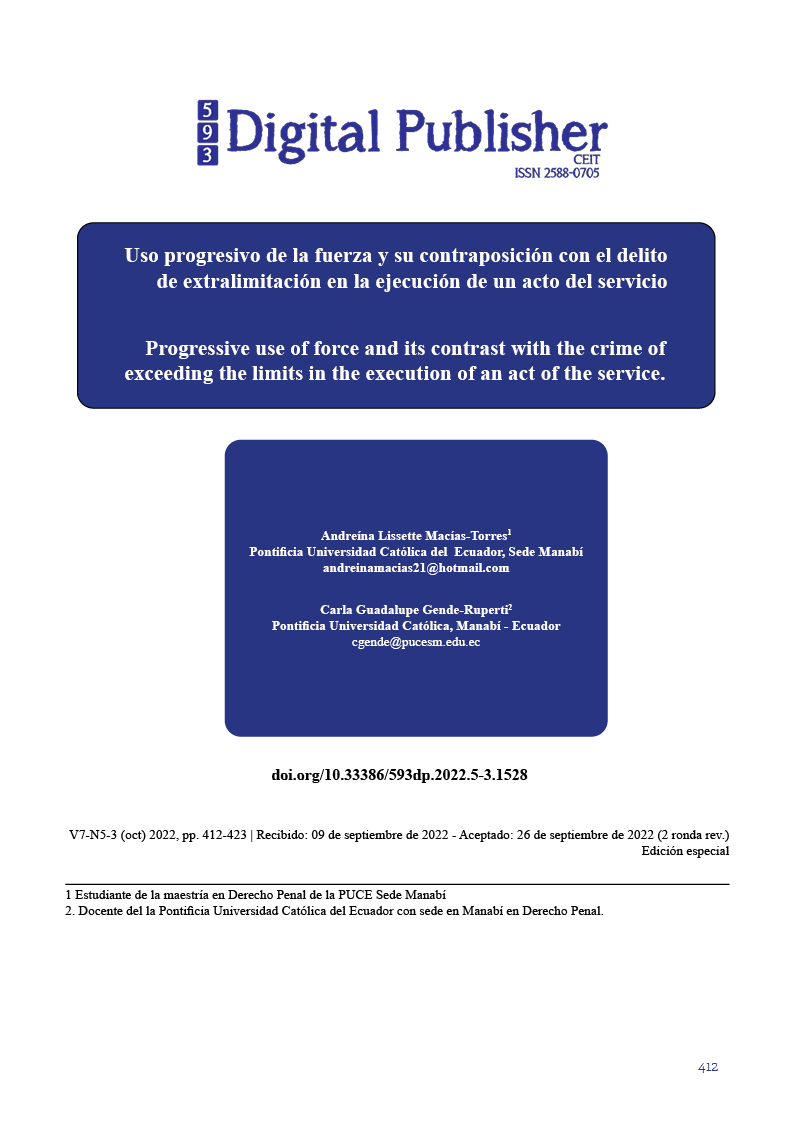Progressive use of force and its contrast with the crime of exceeding the limits in the execution of an act of the service
Main Article Content
Abstract
This investigation is based on determining whether the Ecuadorian State has found a way to provide the necessary support, and in a reliable way, to law enforcement officers to establish a difference between the correct progressive use of force, in each event in which they intervene, detecting if they are prepared to be able to reach an effective execution of the acts of service for which they are called to protect public safety. Since, despite having regulations in Ecuadorian legislation for its correct application, there are precedent events in which there are police officers involved in criminal proceedings for having incurred in the crime of overreach in the execution of an act of service. For which, in this work we will be able to make an extensive study on the progressive use of force and on the need of the Ecuadorian state to protect citizen security.
Downloads
Article Details

This work is licensed under a Creative Commons Attribution-NonCommercial-ShareAlike 4.0 International License.
1. Derechos de autor
Las obras que se publican en 593 Digital Publisher CEIT están sujetas a los siguientes términos:
1.1. 593 Digital Publisher CEIT, conserva los derechos patrimoniales (copyright) de las obras publicadas, favorece y permite la reutilización de las mismas bajo la licencia Licencia Creative Commons 4.0 de Reconocimiento-NoComercial-CompartirIgual 4.0, por lo cual se pueden copiar, usar, difundir, transmitir y exponer públicamente, siempre que:
1.1.a. Se cite la autoría y fuente original de su publicación (revista, editorial, URL).
1.1.b. No se usen para fines comerciales u onerosos.
1.1.c. Se mencione la existencia y especificaciones de esta licencia de uso.
References
Bardález, C. M. (2002). Seguridad ciudadana. Obtenido de https://www.casede.org/index.php/biblioteca-casede-2-0/seguridad/seguridad-ciudadana/100-la-seguridad-ciudadana-en-ecuador-un-concepto-en-construccion/file
DERECHOS, C. I. (07 de marzo de 2006). informe sobre la situación de las defensoras y los defensores de los derechos. Obtenido de https://www.oas.org/es/cidh/defensores/docs/pdf/defensores2011.pdf
diario, E. P.-A. (25 de Mayo de 2006). “TRES POLICIAS Y UN VIOLADOR SE SALVAN DE LA TURBA”.
Ecuador. (19 de Agosto de 2014). Reglamento de uso Legal, Adecuado y Proporcional de la Fuerza para la Policía Nacional del Ecuador. Obtenido de Registro Oficial 314: https://www.policia.gob.ec/wp-content/uploads/downloads/2016/08/REGISTRO-OFICIAL-314.pdf
ECUADOR, A. N. (2014). CODIGO ORGANICO INTEGRAL PENAL . QUITO.
Informe anual 2015, C. I. (2015). Comision Interamericana de Derechos. Obtenido de http://www.oas.org/es/cidh/docs/anual/2015/doc-es/informeanual2015-cap4a-fuerza-es.pdf
INTERIOR, M. D. (10 de JULIO de 2014). ACUERDO MINISTERIAL 4472. Obtenido de https://teoriapolicial.ec/wp-content/uploads/2019/06/USO-DE-LA-FUERZA-ACUERDO-4472-PARA-LA-POLICIA-NACIONAL.pdf
Izquierdo, E. C. (2020). Uso progresivo de la fuerza policial. Obtenido de Estudio de los lineamientos en Ecuador en perspectiva comparada con Perú y: https://repositorio.uasb.edu.ec/bitstream/10644/7568/1/T3281-MDE-Cevallos-Uso.pdf
NACIONAL, A. (2008). CONSTITUCION DE LA REPUBLICA DEL ECUADOR.
Nacional, A. (2009). LEY DE SEGURIDAD PUBLICA Y DEL ESTADO. QUITO.
NACIONAL, A. (16 de Marzo de 2022). Última Reforma: Edición Constitucional del Registro Oficial 20, 16-lll-2022). Obtenido de http://biblioteca.defensoria.gob.ec/handle/37000/3427

